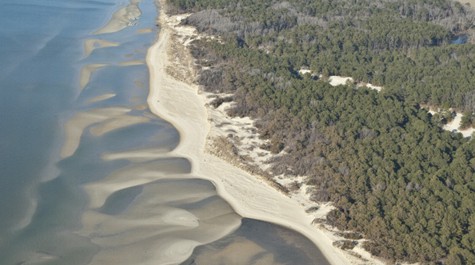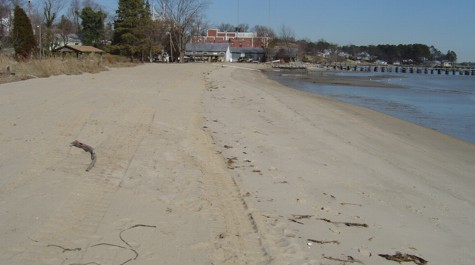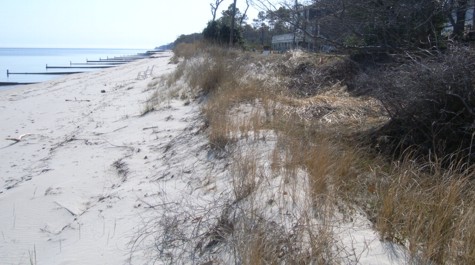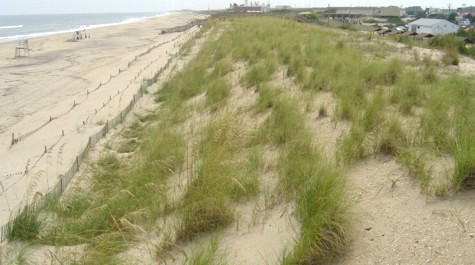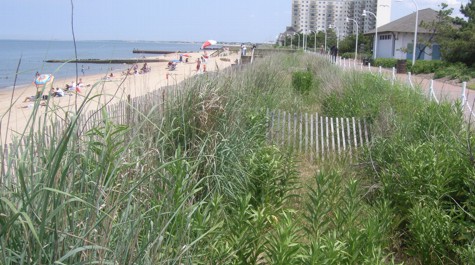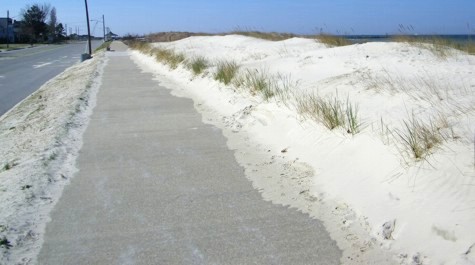Beaches and Dunes in Virginia
Beaches and dunes in Virginia occur in a variety of coastal settings and tide ranges. Natural and man-made beaches and dunes occur along Virginia’s southeast ocean coast, on the barrier islands off Virginia’s Eastern Shore, and in Chesapeake Bay. While the physical processes and ecosystem services are the same, Bay beaches and dunes are generally smaller and less continuous than ocean dunes. Ecosystem services are the benefits resulting from the resources and processes that are supplied by ecosystems.
 Beaches and dunes are part of a system that extends from the nearshore across unvegetated or partially vegetated sand, gravel, or shell intertidal beaches, and into the dune (where they exist). Quartz sand is the foundation that comprises beaches and dunes in Virginia. The sand is eroded from banks and transported into the Bay from creeks and rivers within its watershed as well as from the ocean.
Beaches and dunes are part of a system that extends from the nearshore across unvegetated or partially vegetated sand, gravel, or shell intertidal beaches, and into the dune (where they exist). Quartz sand is the foundation that comprises beaches and dunes in Virginia. The sand is eroded from banks and transported into the Bay from creeks and rivers within its watershed as well as from the ocean.
Beaches are formed by waves and currents. The life span of a beach/dune varies from a few years to several decades, or longer, depending on the sites geomorphology and local sand supply. Beaches are dynamic yet resilient features that are constantly reshaped by waves. In addition to the movement in the onshore-offshore direction, sand is transported alongshore, thus erosion at one site can provide material to an adjacent beach.
When a beach becomes wide enough, a dune can form along its landward side. Dunes form when there is an adequate supply of sand, onshore wind, and stable coastal setting.
Benefits of Beaches and Dunes
Storm Protection
Beaches and dunes provide a buffer zone which protects the upland during storms. Beaches and dunes can dampen and absorb the energy from a wave before it can impact upland structures such as houses and roads. When storms with higher water levels impact the shoreline, dunes can erode, resulting in sand being deposited on the beach or the nearshore. During periods of calm weather, the sand can migrate back up the beach and be blown back onto the dune. Sand fencing installed along the shoreline can help the process by slowing sand so that it accumulates at the base of the fence allowing plants to grow and providing stability to the area.
Habitat
Beaches and dunes provide habitats for many different types of plants and animals. Sea turtles nest along the shore, and mammals and birds forage along the beach in the dunes. Invertebrates, like crabs, insects, and molluscs, live in the nearshore, intertidal zone and back beach. Beaches and dunes are important habitats for migrating and nesting shorebirds and song birds. In Chesapeake Bay, the beaches are important habitats for the threatened northeastern beach tiger beetle.
In Virginia, common dune plants are listed in the Primary Dune and Beaches Act and determine (legally) if a site contains a jurisdictional dune. These common grasses are: American beach grass (Ammophila breviligulata); Beach heather (Hudsonia tomentosa); Amberique-bean (Strophostyles helvola); Dusty miller (Artemisia stelleriana); Saltmeadow cordgrass (Spartina patens); Seabeach sandwort (Honckenya peploides); Sea oats (Uniola paniculata); American Searocket (Cakile edentula); Seaside goldenrod (Solidago sempervirens); Japanese sedge or Asiatic sand sedge (Carex kobomugi); Virginia pine (Pinus virginiana); broomsedge (Andropogon virginicus); and Short dune grass (Panicum amarum).
Water Quality
Both beaches and dunes can positively affect water quality. Beaches are porous and allow the filtration of water and smaller-sized particles in the swash zone (the upper part of the beach between backbeach and surf zone
Plants that live along the back of the beach and in the dunes can take up nutrients that come from the land, either through rain runoff or groundwater discharge.


